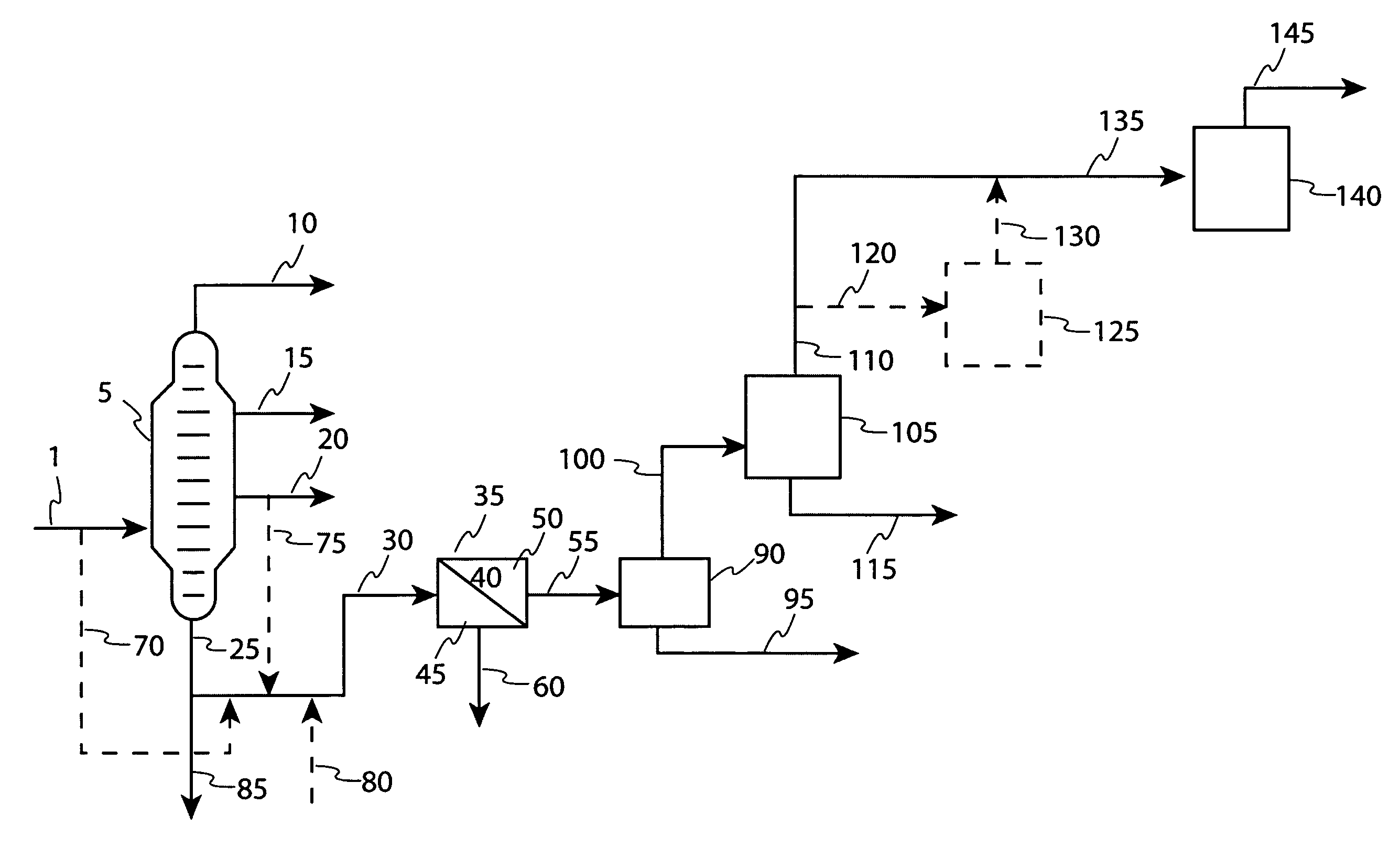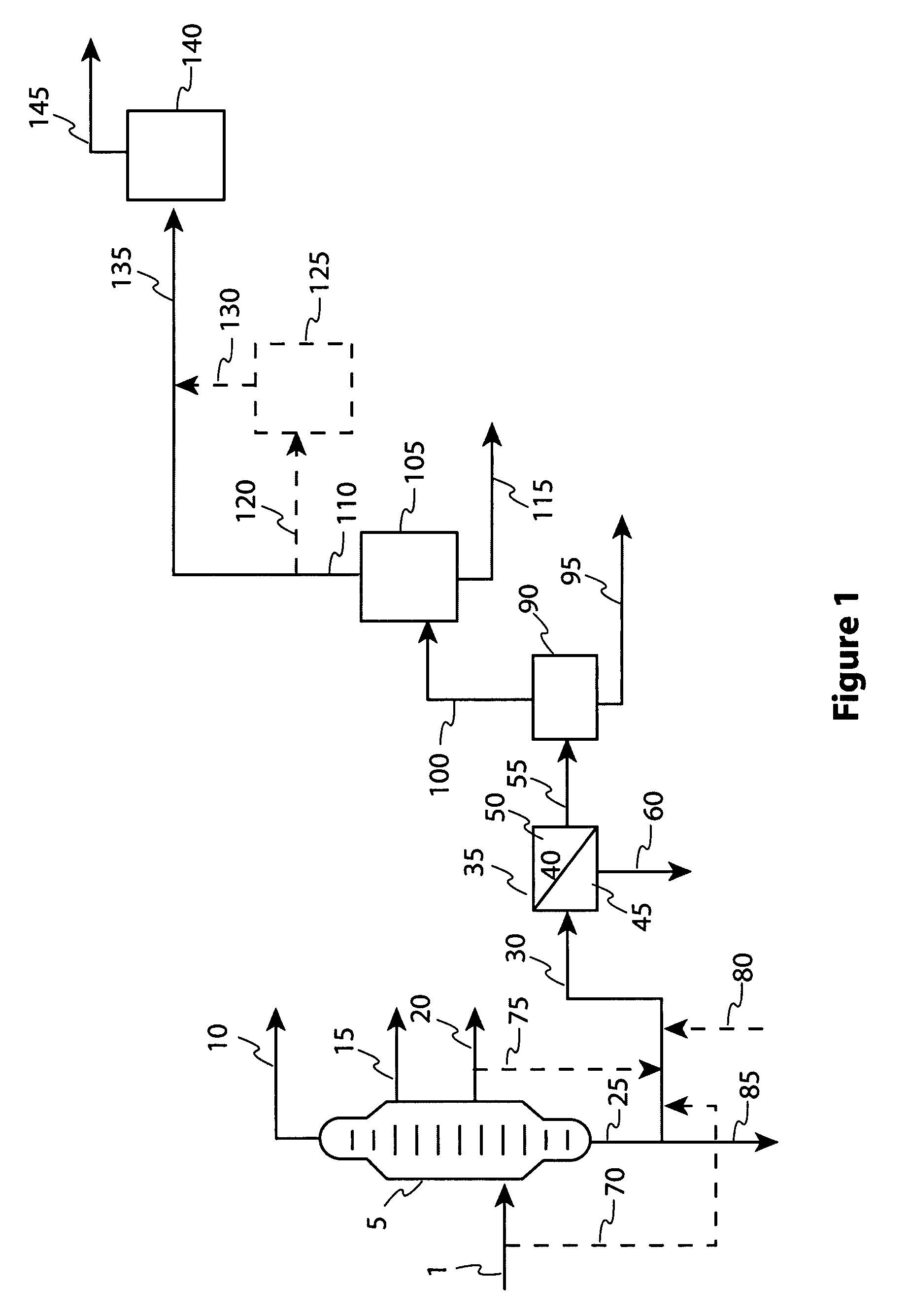Deasphalter unit throughput increase via resid membrane feed preparation
a technology of resid membrane and throughput increase, which is applied in the direction of working up pitch/asphalt/bitumen by selective extraction, working up tar, refining by filtration, etc., can solve the problems of high cost of process equipment, high cost of conventional solvent deasphalting process installation and operation, and the use of valuable hydrocarbon based solvents, etc., to improve the production rate of deasphalted oil and improve the quality of deas
- Summary
- Abstract
- Description
- Claims
- Application Information
AI Technical Summary
Benefits of technology
Problems solved by technology
Method used
Image
Examples
example 1
[0059]In this Example, a lubes vacuum resid was permeated in a batch membrane process using an 8 kD (kiloDalton) ceramic nanofiltration membrane. The pore size of this membrane was estimated to be in the 5 to 10 nanometer range. The transmembrane pressure was held at 1000 psig and the feed temperature was held at 200° C. The flux rates as well as the feed, permeates and retentate wt % Micro Carbon Residue (“MCR”) values are shown in Table 1. The weight percentages of saturates, aromatics, resins, and polars for the feed, permeates and retentate from the experiment are also tabulated in Table 1. The feed was analyzed at the beginning and the end of the test cycle for wt % MCR per test method ASTM D4530 as well as analyzed for weight content of saturate, aromatic, resin, and polar compounds. The permeate samples taken at given intervals and select permeate samples were also tested for wt % MCR as well as analyzed for weight percentages of saturates, aromatics, resins, and polars conte...
example 2
[0063]In this Example, the same lubes vacuum resid was permeated in a batch membrane process utilizing the same type of 8 kD (kiloDalton) ceramic ultrafiltration membrane. The only difference from Example 1 in this example is that the lubes vacuum resid feed temperature was held at 250° C.
[0064]Table 2 shows the data from this test example. In general, it can be seen in Table 2 that higher flux rates were obtained in the process at the higher temperature as compared with Example 1 with accompanying generally lower reductions in MCR wt % content in the permeate samples obtained in the process.
[0065]
TABLE 2PermeatePermeate% Reduction% ReductionTransmembraneFeedstreamFlux RateYield,MCRof MCRof MCRPressureTemperature(gal / ft2 / Cumulative(wt(compared to(compared toSaturatesAromaticsResinsPolarsSample(psi)(° C.)day)(% of feed)%)the feed)the retentate)(wt %)(wt %)(wt %)(wt %)Initial18.87.763.516.911.9FeedPermeate10002501.467.69.648.914.575.48.81.3Sample 1Permeate10002501.0729.79.847.914.076....
example 3
[0066]In this Example, both the lubes vacuum resid feed sample as well as the Permeate 4 sample from Example 1, above were measured for their viscosities at various temperatures. The results of the viscosity testing is shown graphically in FIG. 2 herein. It can be seen from FIG. 2, that the permeate obtained had an appreciably reduced viscosity at all temperatures tested.
[0067]Additionally, the effects of feed viscosity and CCR content on a Propane Deasphalter DAO yield were modeled and the correlated effects are presented in Table 3.
[0068]
TABLE 3Propane DeasphalterFeed ViscosityFeed CCRDAO Yield(centistokes @ 100° C.)(wt %)(wt % of feed)Base Case1470202314701229147010309001235900103775012367501039351242351043
[0069]As can be seen in Table 3, the base case of the modeling data of Table 3 corresponds closely to the CCR content of the lubes vacuum resid feed samples of Examples 1 and 2 as well as the viscosity determined from the same lubes vacuum resid sample as shown in FIG. 2 (i.e.,...
PUM
| Property | Measurement | Unit |
|---|---|---|
| pore size | aaaaa | aaaaa |
| temperature | aaaaa | aaaaa |
| transmembrane pressure | aaaaa | aaaaa |
Abstract
Description
Claims
Application Information
 Login to View More
Login to View More - R&D
- Intellectual Property
- Life Sciences
- Materials
- Tech Scout
- Unparalleled Data Quality
- Higher Quality Content
- 60% Fewer Hallucinations
Browse by: Latest US Patents, China's latest patents, Technical Efficacy Thesaurus, Application Domain, Technology Topic, Popular Technical Reports.
© 2025 PatSnap. All rights reserved.Legal|Privacy policy|Modern Slavery Act Transparency Statement|Sitemap|About US| Contact US: help@patsnap.com



